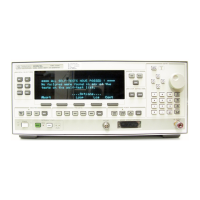c
NOTE:
SP
=
white space, ASCII characters 0,
o
to 9
,.
and 11 ,
o
to 32 ,
o
Figure 1-31. Simplified Common Command Syntax
As with subsystem commands, use a <space> to separate a
command mnemonic from subsequent parameters. Separate adjacent
parameters with a comma. Parameter types are explained later in
this subsection.
Response Message
Figure l-32 shows a simplified view of response message syntax.
Syntax
Figure l-32. Simplified Response Message Syntax
Response messages can contain both commas and semicolons as
separators. When a single query command returns multiple values,
a comma separates each data item. When multiple queries are sent
in the same message, the groups of data items corresponding to each
query are separated by a semicolon. For example, the fictitious query
: QUERY
l?
:
qUERY2?
might return a response message of:
<datal>,
<datal>
;
<data2>,
<data2>
Response data types are explained later in this subsection. Note that
<new line><-END> is always sent as a response message terminator.
1-82 Getting Started Programming

